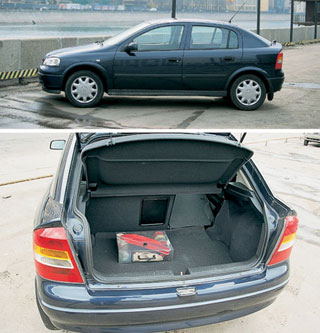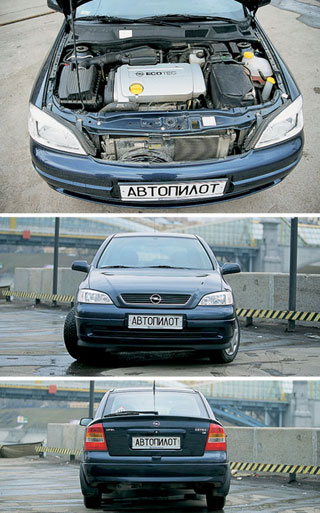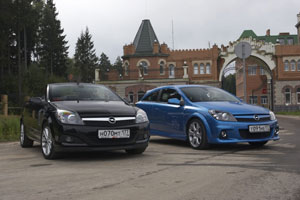Test drive Opel Astra Sedan 1998 - 2008 Sedan
At first sight
 The appearance of the car often corresponds to its character. Such unity of form and content showed us Hyundai Elantra and Opel Astra.
The appearance of the car often corresponds to its character. Such unity of form and content showed us Hyundai Elantra and Opel Astra. In Russia, hatchbacks do not like. At the same time, only one of the reasons looks logically justified: the heat instantly disappears from the cabin if the fifth door is opened in winter. It’s time to forget about the smell of gasoline from the tank and dirt from the tank of the tank and the dirt from the tank in the trunk, at least those who drive a car under 10 years old. Well, the type of type of type looks unprecedented and some stump can be attributed to subjective factors.
We decided to compare the five -door version of the Hyundai Elantra with one of the most popular European models Opel Astra in our market. Both cars have 1.6-liter engines and automatic transmission. However, the latter in Russia is also not very popular-after all, it will increase the car by about a thousand and a half, U.E., the overlain and is inconvenient when leaving the snowdrift. However, if you often have to drive around the city, an automatic machine from an element of comfort turns into an effective means of reducing fatigue.

Guess. Elantra is noticeably longer than Astra (the difference is 385 mm), however, their other sizes are quite close. The fact is that Hyundai preferred the unification of the hatchback and sedan, so to speak, the length of the five -door and four -door versions is the same, they differ only in the roof and doors. Opel chose the option when the hatchback is a shortened version of the sedan, which allows you to save the same rear doors and even rear lights. Therefore, Elantra and Astra are not so easy to guess about the class intimacy-the second looks not only shorter, but also lower and already the first. This is not an Opel reproach: its visual compactness emphasizes the sporting character.
Elantra is clearly oriented towards another consumer. The memorable appearance and pronounced hints of the scope, plus, is fashionable among Asian brands recently the theme of the classics are clearly addressed to those who need a solid car.
Both cars have a small ledge behind - a sort of scar from an amputated protruding trunk. This mini-speed seems to play a completely practical role-the rear window is on Hyundai, and on Opel it practically does not get dirty even when driving along the dirty highway, so the wiper has to be included only in the rain. Although the angle of glass and the ratio of the size of the glass and the roof is probably playing the role in this. Be that as it may, in this regard, the aerodynamics of both machines have been worked out perfectly.

The west-east salons also noticeably differ in character. Astra is no longer very young, and its panel does not look as stylish as the latest Opel models. However, serious claims on ergonomics cannot be presented with it. The salon invariably surprises everyone who judges the car in appearance - the scope is a pleasant surprise. ElanTra, respectively, is not a decent inner size of surprise - this is exactly what you expect from such a car. At the same time, the Korean woman is somewhat surpassed in the equipment: there is an adjustment of lumbar support, you can change the height of the front and rear briefs of the pillow separately, the head restraints have several positions in height. The latter in Opel is partially compensated by the activity of the head restraints - when impact from behind, they must move forward, reducing the range of movement of the head. However, fortunately, we did not have the opportunity to check this mode, but the inability to put the headrest to the desired height annoyed a little. Like the lack of internal lighting on the usual place-one evening I had to look at the atlas of Moscow roads with an open door. Later it turned out that the lamp can be turned on by stretching the light control handle. That the Germans are good ...

The last but very noticeable touch is the design of the instrument panel. On this configuration of Astra from decorative elements - chrome rims. Elantra does not have them, but the scales look more stylish. Especially when the exquisite lilac backlight turns on. By the way, its adjustment also acts on the backlight of the characters on the keys, and the latter can be repaid completely. A sort of imitation of the Black Panel for Saab and Citroen.
Few buttons! In terms of power, the engines of both machines are close: 100 forces for Opel and 107 - at Elantra. True, according to the movement, you might think that the situation is exactly the opposite. This is despite the fact that their mass is almost the same. However, if you compare the movement in normal mode, then Elantra is just for a long time, but if you hold the accelerator pedal pressed, it accelerates well. Opel to Kick Dawn reacts less actively. However, Astra has a sports mode: we press the S button on the lever and the car begins to behave quite briskly. It can be assumed that Elantra could become equally alive, but she does not have such a button. There is only the opportunity to turn off the overdrive (direct gear when the hydrotransformer is not involved), but this is not quite that. It is not surprising that Opel has more surcharge for the Hyundai - $ 1505 versus $ 1300.

A similar difference to the reaction is noticeable not only when communicating with the accelerator. The Opel brake pedal has a fairly short move, and at the same time, with the effort on it, you can very accurately dose the degree of slowdown in the machine. Even, perhaps, too accurately - from habit, it may seem that the brakes cannot be brought to a lock. That is, it is really impossible - there is an ABS, but she practically did not have to turn on, despite the reduced grip of studded tires with asphalt.
Elantra brakes are impressive more: after Opel, you press the pedal like this neatly, at first nothing seems to happen and suddenly - the car slows down sharply. And this can be used to it, but with a relatively long course of the pedal it would be more convenient if the increase in the effort was more uniform. The fundamental difference in the design of the brake system is the presence of disk brakes in the back in Elantra.

Astra wins the steering wheel amplifier algorithm - it is electro -hydraulic and provides a change in the degree of amplification depending on the speed. ElanTra does not happen. Of course, the phrase can be twisted with one finger can impress those who have traveled on the Volga all their lives, but for movement at high speed this is not quite what we would like.
The suspension is just as simply tuned: on the normal road it seems a little softer than that of Opel, however, in terms of transmitting large irregularities to the bodies of passengers, it is more transparent.

The power of inertia. Despite all the efforts of Opel to reduce the cost of his cars in Russia, German origin still provides a noticeable difference in price. Our Astra performed by Comfort now costs $ 16,130, and Elantra GLS with a slightly richest package (four electric glass windows
 instead of two, two pillows instead of one, a radio with six speakers, heated the front seats) - $ 15,290. In both cases, five -door hatchbacks and four -door sedans are the same.
instead of two, two pillows instead of one, a radio with six speakers, heated the front seats) - $ 15,290. In both cases, five -door hatchbacks and four -door sedans are the same. Although, according to Opel, it seemed to us more pleasant, this is a matter of subjective assessment-the style of appearance and expressiveness of the brakes and steering wheel Hyundai may like someone more. Like a much more spacious trunk, and a completely folding rear seat. That's what it would be worth complaining about Hyundai is to the trunk rugs, which are crushed with a raised seat. And to the seals of the door glasses: for the first time I had a chance to see that when lowering, when lowering, it successfully drags a drop of rain inside. It seems that the water in the door of the door is not at all a place ... however, for $ 840 - this is the difference in the price of cars - this can be calculated with a trifle.
Text Valery Chusov, photo Alexey Ilyin
Model/Modification Hyundai Elantra 1.6 GLS Opel Astra 1.6 16V N-Joy
Manufacturer/country Hyundai Motor Company/Republic of Korea Adam Opel AG/Germany
ENGINE
Type/number/location of gasoline cylinders/4/in -line
Working volume (cubic cub) 1599 1598
Power (kW (L.S.) at about./Min.) 79 (107) at 5800 74 (100) at 6000
Moment (nm at about./Min.) 143 at 3000 150 at 3600
TRANSMISSION
Front drive
Automatic gearbox 5-speed
Brakes, safety
Front/rear ABS, assisting electronic systems ventilated disk/disk ABS ventilated disk/drum Abs
Safety pillows 2 frontal 1 frontal
Dimensions/mass
Length/width/height (mm) 4495/1720/1425 4110/1709/1425
Wheel base (mm)/clearance (mm) 2610/168 2614/150
Tires 195/60 R15 195/60 R15
Massage of equipped/complete (kg) 1199/1800 1200/1630
The volume of the fuel tank (L) 55 52
Maximum speed (km/h) 170 178
Acceleration to 100 km/h (sec.) 13.0 13.5
Fuel consumption, city/highway (l/100 km) 11.3/6.3 10.6/6.0
Price in Moscow $ 14,290 $ 16 130
Source: "Autopilot"
Test drive Opel Astra Sedan 1998 - 2008
Crash Test Opel Astra Sedan 1998 - 2008
Krassh Test: Detailed Information25%
Driver and passengers
7%
Pedestrians







